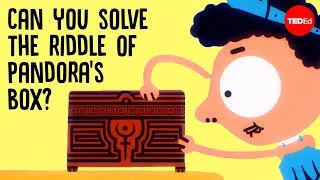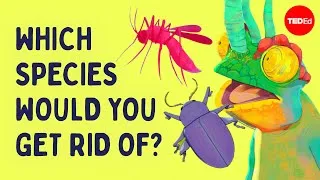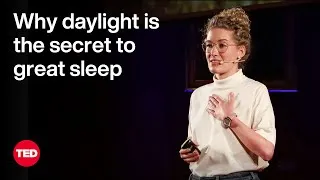請雙擊下方英文字幕播放視頻。
譯者: Sofia Lee
審譯者: Marie Wu
00:25
So, where are the robots?
0
25000
2000
嗯? 所以呢? 那些機器人咧?
00:27
We've been told for 40 years already that they're coming soon.
1
27000
3000
40年來一直有人告訴我們, 機器人很快就會出現在這個世界上了。
00:30
Very soon they'll be doing everything for us.
2
30000
3000
很快地, 他們會替我們做每一件事,
00:33
They'll be cooking, cleaning, buying things, shopping, building. But they aren't here.
3
33000
5000
他們會煮飯, 打掃, 買東西, 購物血拼, 蓋房子, 但是, 他們並沒有出現。
00:38
Meanwhile, we have illegal immigrants doing all the work,
4
38000
4000
現在這當兒, 我們雇用非法移民來替我們完成所有的工作,
00:42
but we don't have any robots.
5
42000
2000
但是, 我們還是沒有機器人呀!
00:44
So what can we do about that? What can we say?
6
44000
4000
所以, 對於這件事我們可以做些什麼? 或者說些什麼呢?
00:48
So I want to give a little bit of a different perspective
7
48000
4000
所以, 我想跟你們分享一些不同的觀點,
00:52
of how we can perhaps look at these things in a little bit of a different way.
8
52000
6000
看看我們能怎樣從不同的角度看待這些事。
00:58
And this is an x-ray picture
9
58000
2000
這是一張大甲蟲和瑞士名錶的X光圖,
01:00
of a real beetle, and a Swiss watch, back from '88. You look at that --
10
60000
5000
是在1988年拍攝的, 你們看看這裡----
01:05
what was true then is certainly true today.
11
65000
2000
當年確實存在的, 現在還是存在。
01:07
We can still make the pieces. We can make the right pieces.
12
67000
3000
我們還是能做出零件, 而且是對的零件,
01:10
We can make the circuitry of the right computational power,
13
70000
3000
我們可以畫出具有運算功能的電路圖,
01:13
but we can't actually put them together to make something
14
73000
3000
但是我們卻沒有辦法把他們組合在一起然後創造出一個東西,
01:16
that will actually work and be as adaptive as these systems.
15
76000
5000
而那個東西又要能夠跟這些系統一樣運作良好又具備適應能力。
01:21
So let's try to look at it from a different perspective.
16
81000
2000
那麼讓我來試著從不一樣的角度看看,
01:23
Let's summon the best designer, the mother of all designers.
17
83000
4000
我們來召喚一個設計師--他是所有設計師的老師:
01:27
Let's see what evolution can do for us.
18
87000
3000
我們來看看演化為我們做了些什麼。
01:30
So we threw in -- we created a primordial soup
19
90000
4000
我們創造一種最原始的湯汁,
01:34
with lots of pieces of robots -- with bars, with motors, with neurons.
20
94000
4000
我們丟入很多機器人的碎片, 裡面包含了拉桿, 引擎和神經,
01:38
Put them all together, and put all this under kind of natural selection,
21
98000
4000
把他們全部放在一起, 然後讓他們面對物競天擇、
01:42
under mutation, and rewarded things for how well they can move forward.
22
102000
4000
突變,並依據他們發展的情況給予獎賞。
01:46
A very simple task, and it's interesting to see what kind of things came out of that.
23
106000
6000
這是很簡單的工作,而且觀察這個演化過程也十分有趣。
01:52
So if you look, you can see a lot of different machines
24
112000
3000
仔細一瞧,你就會發現很多不一樣的機器被創造出來了
01:55
come out of this. They all move around.
25
115000
2000
他們到處走來走去,
01:57
They all crawl in different ways, and you can see on the right,
26
117000
4000
他們都往不同的方向爬,你們可以在右邊
02:01
that we actually made a couple of these things,
27
121000
2000
看到我們做出來的成果,
02:03
and they work in reality. These are not very fantastic robots,
28
123000
3000
他們都可以在現實生活中執行任務, 你看到的這些都不是多高檔的機器人,
02:06
but they evolved to do exactly what we reward them for:
29
126000
4000
但是他們卻完全依照我們所給的獎賞而演化。
02:10
for moving forward. So that was all done in simulation,
30
130000
3000
這些雖然都是在電腦上模擬出來的,
02:13
but we can also do that on a real machine.
31
133000
2000
但我們也可以讓真的機器做出相同的事。
02:15
Here's a physical robot that we actually
32
135000
5000
這就是一個我們實際上可以看到的機器人,
02:20
have a population of brains,
33
140000
3000
他有好幾個大腦,
02:23
competing, or evolving on the machine.
34
143000
2000
這幾個大腦在這機器上彼此競爭並且演化,
02:25
It's like a rodeo show. They all get a ride on the machine,
35
145000
3000
就像賽馬一樣: 他們會騎到機器上,
02:28
and they get rewarded for how fast or how far
36
148000
3000
他們之中讓機器跑得越快越遠的,
02:31
they can make the machine move forward.
37
151000
2000
就可以得到越多獎賞。
02:33
And you can see these robots are not ready
38
153000
2000
現在你可以看到這些機器人
02:35
to take over the world yet, but
39
155000
3000
還沒準備好取代人類統治這個世界,
02:38
they gradually learn how to move forward,
40
158000
2000
不過他們慢慢學會要怎麼往前走了,
02:40
and they do this autonomously.
41
160000
3000
而且他們是完全自主地前進著。
02:43
So in these two examples, we had basically
42
163000
4000
在剛剛提到的兩個例子裡, 我們基本上擁有兩種機器,
02:47
machines that learned how to walk in simulation,
43
167000
3000
第一種是以電腦模擬的方式學習走路,
02:50
and also machines that learned how to walk in reality.
44
170000
2000
第二種則是在現實生活中學習前進。
02:52
But I want to show you a different approach,
45
172000
2000
但是我要讓你們看的是另一種更不一樣的方式,
02:54
and this is this robot over here, which has four legs.
46
174000
6000
請看, 這隻機器人有四隻腳,
03:00
It has eight motors, four on the knees and four on the hip.
47
180000
2000
八個引擎, 四個在膝蓋的地方, 另外四個在臀部。
03:02
It has also two tilt sensors that tell the machine
48
182000
3000
他還有兩個傾斜感應器,
03:05
which way it's tilting.
49
185000
3000
用來感應自己向哪裡傾斜了。
03:08
But this machine doesn't know what it looks like.
50
188000
2000
但是這機器並不知道他自己長什麼樣子,
03:10
You look at it and you see it has four legs,
51
190000
2000
你看得到他, 所以知道他有四隻腳。
03:12
the machine doesn't know if it's a snake, if it's a tree,
52
192000
2000
但是這機器卻沒辦法知道他自己是一條蛇還是一顆樹,
03:14
it doesn't have any idea what it looks like,
53
194000
3000
他完全不清楚自己長什麼樣子,
03:17
but it's going to try to find that out.
54
197000
2000
但是他會想辦法知道。
03:19
Initially, it does some random motion,
55
199000
2000
一開始, 他會隨機做一些動作,
03:21
and then it tries to figure out what it might look like.
56
201000
3000
接著他試圖看出自己大概長什麼樣子--
03:24
And you're seeing a lot of things passing through its minds,
57
204000
2000
你會看到他腦海中浮現非常多東西,
03:26
a lot of self-models that try to explain the relationship
58
206000
4000
有很多他自己創造的動作模式, 他試圖去釐清
03:30
between actuation and sensing. It then tries to do
59
210000
3000
動作和感知之間的關係─然後他再試著做第二個動作,
03:33
a second action that creates the most disagreement
60
213000
4000
那個動作不在既有的動作模式內,
03:37
among predictions of these alternative models,
61
217000
2000
完全出乎我們的意料,
03:39
like a scientist in a lab. Then it does that
62
219000
2000
就像在實驗室裡的科學家一樣。接著, 他重複那個動作,
03:41
and tries to explain that, and prune out its self-models.
63
221000
4000
並且試著解釋那個動作, 然後創造出自己的動作模式。
03:45
This is the last cycle, and you can see it's pretty much
64
225000
3000
這是他最後一次重覆這整個循環, 你可以看到他
03:48
figured out what its self looks like. And once it has a self-model,
65
228000
4000
已經弄清楚自己的樣子了, 一旦他整理出自己的動作模式,
03:52
it can use that to derive a pattern of locomotion.
66
232000
4000
就可以從中發展出一種運動模式。
03:56
So what you're seeing here are a couple of machines --
67
236000
2000
你現在看到的是幾個機器─
03:58
a pattern of locomotion.
68
238000
2000
一種運動模式。
04:00
We were hoping that it wass going to have a kind of evil, spidery walk,
69
240000
4000
我們期待他做出一種如惡魔或者蜘蛛般的行走模式,
04:04
but instead it created this pretty lame way of moving forward.
70
244000
4000
但是他卻創造出這種看似殘障的前進方法。
04:08
But when you look at that, you have to remember
71
248000
3000
但是當你看著他前進的時候, 你必須記得,
04:11
that this machine did not do any physical trials on how to move forward,
72
251000
6000
這機器並沒有做過任何往前行進的物理試驗,
04:17
nor did it have a model of itself.
73
257000
2000
他也沒有任何屬於自己的模式,
04:19
It kind of figured out what it looks like, and how to move forward,
74
259000
3000
他等於是自己發現了自己的樣子, 然後找出前進的方法,
04:22
and then actually tried that out.
75
262000
4000
並實際驗證成功。
04:26
(Applause)
76
266000
5000
(掌聲響起)
04:31
So, we'll move forward to a different idea.
77
271000
4000
那麼現在, 我們再來看看另一種想法,
04:35
So that was what happened when we had a couple of --
78
275000
5000
那是我們將幾個─
04:40
that's what happened when you had a couple of -- OK, OK, OK --
79
280000
4000
把幾個放在一塊兒就會......好啦好啦好啦!!!
04:44
(Laughter)
80
284000
2000
(笑聲)
04:46
-- they don't like each other. So
81
286000
2000
─他們不太喜歡對方, 所以
04:48
there's a different robot.
82
288000
3000
這是另一個機器人。
04:51
That's what happened when the robots actually
83
291000
2000
剛剛的事情都是因為機器人做對動作,
04:53
are rewarded for doing something.
84
293000
2000
並且得到獎勵才發生的。
04:55
What happens if you don't reward them for anything, you just throw them in?
85
295000
3000
那如果們不給他們獎勵, 直接把他們丟在一塊會怎麼樣呢?
04:58
So we have these cubes, like the diagram showed here.
86
298000
3000
所以我們拿來了這些立方體, 就像你在圖上看到的,
05:01
The cube can swivel, or flip on its side,
87
301000
2000
他們會旋轉或者翻轉。
05:04
and we just throw 1,000 of these cubes into a soup --
88
304000
4000
我們把一千個這樣的立方體放入"原始湯汁"裡─
05:08
this is in simulation --and don't reward them for anything,
89
308000
2000
這是電腦模擬效果─我們沒有給他們任何獎勵,
05:10
we just let them flip. We pump energy into this
90
310000
3000
就讓他們翻轉而已。我們給他們一些能量,
05:13
and see what happens in a couple of mutations.
91
313000
3000
看看經過幾次突變以後會怎樣。
05:16
So, initially nothing happens, they're just flipping around there.
92
316000
3000
剛開始什麼都沒發生, 他們就只是跳來跳去,
05:19
But after a very short while, you can see these blue things
93
319000
4000
但又過了一下, 你就會看到右邊那些
05:23
on the right there begin to take over.
94
323000
2000
藍色的東西開始掌控全局。
05:25
They begin to self-replicate. So in absence of any reward,
95
325000
4000
他們開始自我複製, 由此可見就算沒有獎勵,
05:29
the intrinsic reward is self-replication.
96
329000
3000
他們也會用自我複製的方式獎勵自己。
05:32
And we've actually built a couple of these,
97
332000
1000
實際上我們已經製造了好幾個像這樣的玩意兒,
05:33
and this is part of a larger robot made out of these cubes.
98
333000
4000
這是用這樣的立方體做出來的機器人其中的一部分,
05:37
It's an accelerated view, where you can see the robot actually
99
337000
3000
我們用快轉的方式,讓你看看這機器人
05:40
carrying out some of its replication process.
100
340000
2000
進行自我複製的過程。
05:42
So you're feeding it with more material -- cubes in this case --
101
342000
4000
如果你多餵給這個機器人一些原料─那些立方體─
05:46
and more energy, and it can make another robot.
102
346000
3000
還有很多能量, 他可以製造出另一個機器人。
05:49
So of course, this is a very crude machine,
103
349000
3000
當然, 這是一個很粗糙的機器,
05:52
but we're working on a micro-scale version of these,
104
352000
2000
但是我們正努力做出這種機器人的縮小版,
05:54
and hopefully the cubes will be like a powder that you pour in.
105
354000
3000
希望這些立方體可以小到跟粉末一樣。
05:57
OK, so what can we learn? These robots are of course
106
357000
5000
好吧!那麼我們學到了些什麼呢?這些機器人
06:02
not very useful in themselves, but they might teach us something
107
362000
3000
本身不一定多有用, 但他們卻可以教會我們一些事情,
06:05
about how we can build better robots,
108
365000
3000
關於我們如何做出更好的機器人,
06:08
and perhaps how humans, animals, create self-models and learn.
109
368000
5000
甚至是人類或動物創造自我模式跟學習的機制原理。
06:13
And one of the things that I think is important
110
373000
2000
還有一樣我覺得最重要的,
06:15
is that we have to get away from this idea
111
375000
2000
就是我們要放棄
06:17
of designing the machines manually,
112
377000
2000
以人工設計機器的想法,
06:19
but actually let them evolve and learn, like children,
113
379000
3000
放手讓機器自己演化與學習, 像孩子一樣,
06:22
and perhaps that's the way we'll get there. Thank you.
114
382000
2000
這或許才是讓我們成功的辦法, 謝謝!
06:24
(Applause)
115
384000
2000
(掌聲)
New videos
關於本網站
本網站將向您介紹對學習英語有用的 YouTube 視頻。 您將看到來自世界各地的一流教師教授的英語課程。 雙擊每個視頻頁面上顯示的英文字幕,從那裡播放視頻。 字幕與視頻播放同步滾動。 如果您有任何意見或要求,請使用此聯繫表與我們聯繫。







